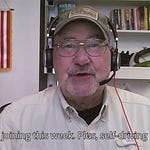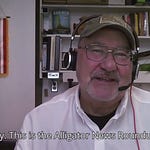A 200-lb man lay on his back on a steep grass-covered embankment, a 60,000-lb semi truck laying on its side above him, trapping his legs. Gravity slowly pulled the bulk of the truck downward, inching toward him as it slipped across the grass.
I missed the action by 20 minutes.
This story is a metaphor for thoughtful preparation for the unthinkable.
I’ll bet that was an exciting ride
At the north end of the city, a complicated road interchange handled the intersection of two limited-access four-lane highways. When it was designed 20 years earlier it was a beautiful addition to safe driving.
It did not age well.
Traffic volumes increased drastically and automobile speeds got much faster. What was a modern convenience in 1970 was an unwelcome slow-down by 1990.
The transition from north-bound to west-bound meant a tight, corkscrew right-hand exit onto a ramp that should have taken three times more real estate than it used. The turn was marked at 20 mph, down from 60 on the straightaway.
On the outside of the curve, an embankment sloped steeply down. While the pavement was banked to allow the tight turn, a driver starting the corkscrew too fast had no chance to slow.
The truck was what they call a dry van: A full-length 40-foot box trailer behind the semi tractor. It had entered the turn too fast, lost control and rolled over the edge, coming to rest on its side, easing toward a downhill slide.
The driver had somehow been ejected from the cab, and, incredibly, had fallen onto the grass beneath the descending wreck. He had been trapped, head down-slope, legs immobilized under the shuddering carcass of his truck.
When I came on the scene, police cars had the road blocked. The victim had already been extricated and evacuated. Traffic was still diverted. Fire trucks idled.
The fire department called for help
I noted with interest that the first response units, bright red fire engines, were from the city. This was to be expected. But there were also two units from the neighboring county, in their distinctive lime green color. It was unusual to see them alongside the big boys from the metropolis. The county trucks were one-ton units, normally used for rural grass fires. They were dwarfed by the red ladder truck and pumper unit.
At the time, I served on the board of a rural fire district in that same county. The trucks were not from my jurisdiction, but I was interested in why they had showed up. The legal framework dictated that they must formally be requested for mutual aid. I knew the jurisdictions had the legal agreements in place, but why had a city of 300,000 called on grass fire rigs from a county one-tenth their size?
At the moment, the activity level among the responders was low. The tow truck drivers were discussing how to get the monster back up onto the road.
I left my car, safe at the side of the road, and approached a small group of firefighters. They looked up as I approached.
"Hey, men. Where’s the County Fire Chief?”
“Right here,” a tall sandy-haired man replied. He wore bunker gear that had been around for a while; boots and helmet scratched. “Can I help you?”
I explained I served on the board of a neighboring fire district and was interested in what his crew was doing at a scene in the next county. “Did you guys get mutual aided?”
“Sure did,” he replied with a nod, and the tinges of a slight smile formed on his lips. “They didn’t have the gear they needed.”
I paused and felt my eyes narrow. “And you did?”
He grinned widely. “Yep,” he said. “They needed air lift bags and didn’t have any.”
Right equipment, right time, right place
I was new to the business, unfamiliar with the equipment, and a little lost. “Air lift bags?”
“Sure,” he said. “Its a super heavy-duty bag, square and flat when it’s empty. You pump air into it and it inflates.” He nodded to the semi truck on its side. “That box was laying on the guy’s legs. A jack wouldn’t help; the base would have sunk into that soft dirt, and the top would just poke a hole in the skin of the truck.”
“So you insert the flat bag under the edge of the truck and put the air to it.”
“That’s right. Once we showed up, it took about two minutes to get him free.”
“And a half-hour of travel time.”
He shrugged. “Can’t roll till we get the call.”
“How is it that the city doesn’t have any, but you guys out in the sticks do?”
Another shrug. “Budgets, I guess. And we get a lot of truck traffic on the highway outside of town. But today was a good chance to shame the big boys, and show ‘em we ain’t just a bunch of hicks.”
What I took away from this conversation was that someone in the rural county had considered worst-case scenarios and decided to prepare for them.
At a later fire board meeting I queried our own Chief about the complement of hand tools in his trucks: Shovels, rakes, crowbars, pry bars, axes. The answers were reasonable, though previous board management had prevented him from standardizing his trucks. We fixed that, at a very slight cost.
The lesson of the air lift bags stuck with me. When problems occur, they are usually never as bad as they could be. But the reason most problems are insignificant is because of prior preparation.
The rural fire department had a solution, and somewhere there is a truck driver who was very glad they did. His predicament still gives me chills.
I never learned his condition after the accident.
Takeaway
When my ancient Ford pickup caught fire (because of a stupid move I had made under the hood during maintenance) I simply used the fire extinguisher in the garage to solve the problem. (And then spent the next 30 minutes cleaning the carbon tetrachloride out of the valve assembly. And later spent $30 on a new fire extinguisher.)
When the lights went out during a thunderstorm one night, I grabbed the flashlight off the nightstand. No issue.
It has occurred to me that the big issues of life are about that simple. Poor health? See the doctor, get the advice, develop the plan and follow it. You may not become a poster-child for fitness, but the point is to maximize what God gave you.
The same is true for your finances. Identify the problems, outline the solutions, and move forward.
Leaving a legacy that resonates with those who follow is the one that occupies much of my thinking. How to organize the thoughts, streamline the lessons, verbalize the principles, and present it all in a package that someone else will actually care to read?
There is no prize if no one accesses it.
Whether you are 20 (like I used to be) or 70 (like I am now), today is a good time to take stock of where you are, where you want to be, and how you will get there.
To completely rip the Apostle’s words out of context:
Indeed, the “right time” is now.
2 Corinthians 6:2 NLT
A friend is launching an initiative called Your Best Retirement, aimed at planning and executing a relevant, healthy lifespan that serves others and honors God. I will help him in that effort. (No financial advice is given, and no financial product sales are offered.)
This works for the 20-something just starting, it works for the retiree, and it works for everyone in between.
If you like, I can send you a very brief overview of what this is about. Reach out to me at curt@alligatorpublishing.com for information. Have a good week! And pay attention to your driving!















Share this post